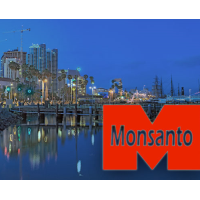San Diego Sues Monsanto over 50 Years of PCB Contamination in the Bay
 (Image: Michael Seljos, Creative Commons)
(Image: Michael Seljos, Creative Commons)
Lawsuits against Monsanto over its manufacture of the one-time omnipresent polychlorinated biphenyls (PCBs) are so 1980s. And 1990s. In fact, they’ve never really gone out of style, and ruinous PCBs have never really left the environment.
San Diego and its port sued Monsanto and two related companies in federal court this week over the dumping of PCB materials in the bay from the 1930 through the 1970s. Congress banned its manufacture in 1979.
The lawsuit claims that Monsanto continued to manufacture PCBs long after their danger was known and consequently a bunch of it ended up in the bay, according to the San Diego Reader. “PCBs manufactured by Monsanto have been found in Bay sediments and water and have been identified in tissues of fish, lobsters, and other marine life in the Bay,” the lawsuit says.
They were “a primary driving force behind the need to clean up and abate Bay sediments.” That need to clean up the bay cost the city and port dearly in 2014 after the San Diego Regional Water Control Board held them responsible for the dumping of others. They paid fines of $949,634 and coughed up $6.45 million to clean up the Shipyards Sediment Site.
The city and port hope to recoup some of their costs in the lawsuit.
The lawsuit said that Monsanto knew it, and others like it, were coming. It quotes an internal Monsanto report:
“There is little probability that any action that can be taken will prevent the growing incrimination of specific polychlorinated biphenyls as nearly global environmental contaminants leading to contamination of human food (particularly fish), the killing of some marine species (shrimp), and the possible extinction of several species of fish eating birds.”
The U.S. Environmental Protection Agency (EPA) says, “PCBs have been demonstrated to cause cancer, as well as a variety of other adverse health effects on the immune system, reproductive system, nervous system, and endocrine system.” You can read the details here.
Right up until the end, Monsanto pushed the product, which was found in everything from food packaging to paint, as safe. In 2000, Solutia Inc., the company spun off by Monsanto to handle its chemical operations, argued in Chemical Week, “The overwhelming weight of scientific evidence suggests there are no chronic human health effects associated with exposure to PCBs.”
PCBs were used in motor oil, plastics, dyes, rubber products, insulation, adhesives, electrical capacitors, transformers and floor finishes. Very few people escaped exposure to the chemical in its product use or in the wild, where PCBs and their byproducts were dumped or allowed to leach into the environment.
PCBs are persistent organic compounds that don’t easily break down and dissipate. The EPA says,
“PCBs can still be released into the environment from poorly maintained hazardous waste sites that contain PCBs; illegal or improper dumping of PCB wastes; leaks or releases from electrical transformers containing PCBs; and disposal of PCB-containing consumer products into municipal or other landfills not designed to handle hazardous waste. PCBs may also be released into the environment by the burning of some wastes in municipal and industrial incinerators.”
The lawsuit, filed in U.S. District Court in California's Southern District, names Monsanto, Solutia Inc., and Pharmacia Corporation, a Pfizer Inc-owned company once inherited by Monsanto's pharmaceutical business.
–Ken Broder
To Learn More:
Monsanto: Pay for Damaging San Diego (by Dorian Hargrove, San Diego Reader)
San Diego Sues Monsanto over PCB Pollution (by Ben Unglesbee, St. Louis Business Journal)
San Diego Sues Monsanto for Polluting Bay with Banned Carcinogenic Chemicals (by Sarah Lazare, Common Dreams)
Monsanto Knew About PCB Toxicity for Decades (Chemical Industry Archives)
PCBs from A to Z: A Reemerging Toxic Tort Concern (Harris Beach PLLC) (pdf)
- Top Stories
- Controversies
- Where is the Money Going?
- California and the Nation
- Appointments and Resignations
- Unusual News
- Latest News
- California Forbids U.S. Immigration Agents from Pretending to be Police
- California Lawmakers Urged to Strip “Self-Dealing” Tax Board of Its Duties
- Big Oil’s Grip on California
- Santa Cruz Police See Homeland Security Betrayal in Use of Gang Roundup as Cover for Immigration Raid
- Oil Companies Face Deadline to Stop Polluting California Groundwater





